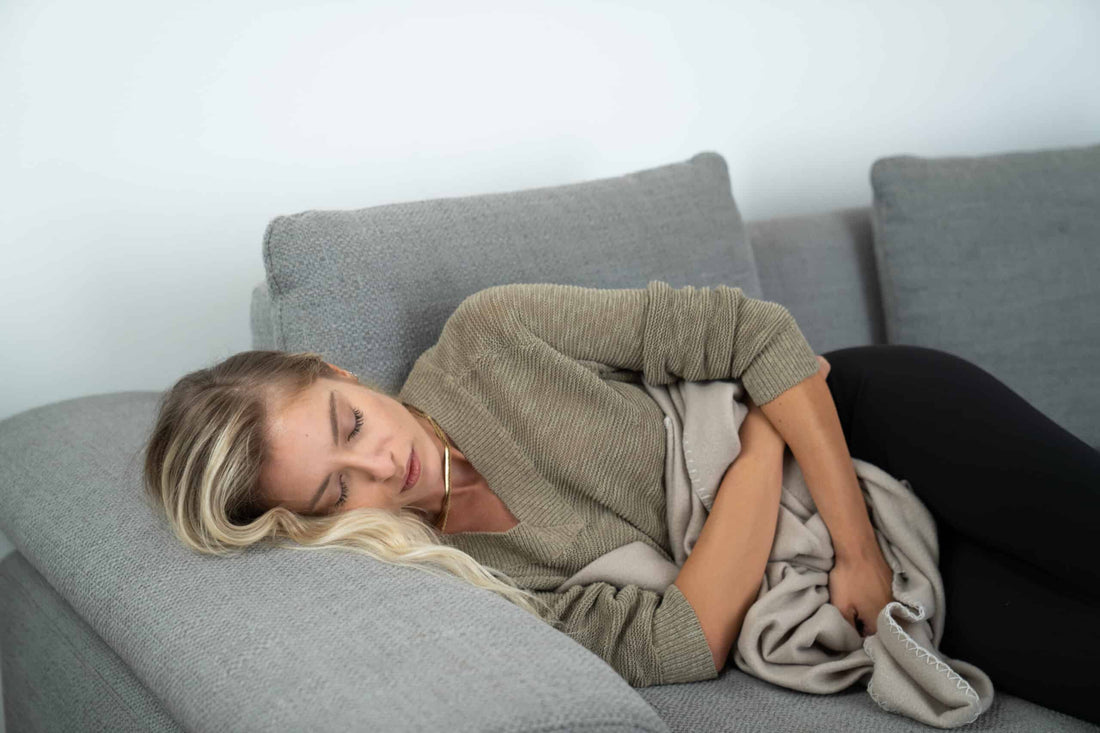Are you one of the 80 percent of women who struggle with period pain, also known as dysmenorrhea? In a survey, more than 700 out of 1,000 participants reported experiencing cramps and abdominal pain during their period. Unfortunately, this pain can be so severe that many women are unable to continue their normal daily routine [1], [2] .
Since period pain is a problem for many menstruating women, medicine has long assumed that the discomfort is normal and merely an annoying side effect of menstruation. How would you react if we told you that there are other options besides painkillers that can finally help you avoid severe cramps?
At Hello Inside, we want to help you better understand period pain. Here, you'll learn how to alleviate your symptoms and how to get through your cycle pain-free with a healthy diet and stable blood sugar.
Period pain / dysmenorrhea – symptoms
Like so many things in life, period pain varies from woman to woman. While some experience little to no pain, others find it unbearable. 10 out of 100 women are unable to go about their normal daily routine for up to three days a month. Even the slightest movement is painful, and the hot water bottle becomes their best friend [3] .
How do period pains manifest themselves?
You're probably most familiar with period pain, which often involves severe abdominal cramping. This pain can also radiate into your back or legs.
In addition to the cramps, the following symptoms may also occur [3] :
- nausea
- Vomit
- Diarrhea
- Headache
Menstrual pain is caused by the contraction of the uterine muscles
Period pain is a result of women's biology. With each cycle, the female body prepares for pregnancy. It produces increased levels of female sex hormones, which stimulate ovulation and encourage the uterus to produce more lining. This allows a fertilized egg to implant more easily.
However, if the egg isn't fertilized, everything resets to zero. The cervical mucus must then be expelled so that new mucus can be produced in the next cycle. The uterine muscles contract to release the mucus. If the muscles contract strongly, this contraction can become painful in the form of cramps.
If you want to know more about menstruation, we recommend our informative article about the female cycle and hormones .
Period pain – causes
Medicine distinguishes between two different forms of period pain, which have different causes, namely [4] :
- primary dysmenorrhea
- secondary dysmenorrhea
Primary dysmenorrhea is the result of inflammation
Most girls experience primary dysmenorrhea during their very first period. Hormone-like substances called prostaglandins cause pain.
Prostaglandins cause the uterus to contract. They also trigger inflammation, which is only mild. However, the more prostaglandins your body produces, the more severe the inflammation becomes. The result: more pain [3] .
The reason your body produces increased levels of prostaglandins may be related to your diet, for example. Furthermore, elevated blood sugar may fuel further inflammation, causing pain to become more severe [5] .
In the course of this article, you will learn more about nutrition and period pain.
Secondary dysmenorrhea is caused by an underlying disease
There are several diseases associated with (severe) period pain, such as endometriosis . This is where the uterine lining grows and attaches itself to organs like the stomach or intestines, or to the muscles. Tumors or chronic inflammatory bowel diseases , such as Crohn's disease and ulcerative colitis, also increase the risk of severe period pain.
If you use a copper IUD for contraception, it can also turn out to be a possible cause [3], [4] .
Severe period pain is not normal. So don't be afraid to see your gynecologist about it. Severe period pain is often due to secondary dysmenorrhea. Even though it can take a lot of patience and energy for doctors to find the cause through proper examinations, we want to encourage you to take care of yourself and your health. This way, you can succeed in improving your well-being and health in the long term even when experiencing unbearable pain. Always think of yourself and your health first and foremost. Our tips can also help you. So don't lose heart [4] .
These tips will relieve your period pain
Painkillers are often used for severe period pain. Often, people lack proper information and awareness that there are other options for treating period cramps. Our tips will not only help you relieve the pain but are also generally good for your health:
- Reduce foods that significantly increase blood sugar
- Avoid cravings
- Focus on healthy fats
- Gentle exercise can relieve period pain
- You can't go wrong with warmth
Reduce foods that significantly increase blood sugar
Foods like white flour products, convenience foods, sweets, and soft drinks are full of fast-acting carbohydrates . While they give foods a delicious sweet taste, they're your ticket to a blood sugar roller coaster . They raise blood sugar quickly and sharply.
If you consume these foods more often during your period, your blood sugar will skyrocket. This will only increase your period pain. This is because the prostaglandins already cause inflammation, and elevated blood sugar can fuel further inflammation. Imagine it like this: the prostaglandins are already starting small fires and further igniting the many sugar molecules in your diet. Ultimately, an inferno ensues, which worsens the pain.
If you suffer from severe period pain, it is helpful to check your blood sugar regularly. This can help you determine which foods significantly increase your blood sugar [6] .
Avoid cravings
During premenstrual syndrome , the days before your period, you may experience food cravings. This is also related to your blood sugar, which is more sensitive, leading to more pronounced fluctuations. Cravings for sweet and fatty foods increase, foods that can promote inflammation and thus pain.
To avoid cravings , you should focus on a high-fiber diet. Choose whole grains and plenty of vegetables for your main meals. Protein-rich snacks like a handful of nuts also help prevent cravings. It also always helps to chew food thoroughly and for a long time. This will keep you fuller longer. And if you do get a strong craving for something sweet, don't make it harder than it is. Try to curb your hunger with a piece of dark chocolate, nuts, or some fruit. This is best served as a dessert rather than a snack between meals.
Focus on healthy fats
Omega-3 and omega-6 fatty acids play an important role in your heart health and inflammatory processes. While omega-3 fatty acids prevent inflammation, omega-6 fatty acids promote inflammation. Thus, there is a possible connection between omega-6 fatty acids and period pain. In today's diet, we consume more omega-6 than omega-3 fatty acids, which increases the risk of inflammation [7]–[9] .
Since it is not always easy to understand where which fats are contained, we have created a table for you to give you an overview.
| Foods rich in Omega-3 | Foods rich in Omega-6 |
|---|---|
| linseed oil, rapeseed oil | Thistle, sunflower, Corn germ, coconut, soybean oil |
| Flax seeds, chia seeds | Butter, lard |
| Walnuts | red meat |
| Salmon, herring, mackerel |
When choosing oils, always make sure they're virgin and cold-pressed. This means they're not heavily processed and still retain most of their essential nutrients.
Learn more about why fats are better than their reputation in our informative article.
Fried foods and convenience foods often contain high amounts of trans fats , which also promote inflammation. Ideally, you should avoid them in the days before and during your period.
Gentle exercise can relieve menstrual pain
Whether it's yoga exercises or a short walk, some physical activity can relieve menstrual pain, as long as the pain isn't too severe. Don't force yourself and don't stress your body more than it already is.
You may be able to get support through physical therapy . Therapists can show you different exercises to relieve your symptoms [10] .
You can't go wrong with warmth
Seed pillows and hot water bottles are probably the most commonly used remedies for period pain. The warmth helps relieve cramps, relaxes us, and makes us feel comfortable.
Even a warm tea can work wonders. Some studies have shown that green tea and lady's mantle tea can relieve menstrual pain. Ginger, a warming, soothing spice, is also said to have positive effects [11]–[13] .
Tip: In addition to heat, the mineral magnesium also has antispasmodic properties. Ask a pharmacy which preparation is suitable [14] .
In short – Get to know your body
For too long, menstrual pain has been downplayed and treated only with painkillers. Even small changes can have a big impact. It's important not to try to change all your habits at once. Taking too many steps too quickly at once will only make you stumble and reach your goal more slowly, if at all. Remember, one step at a time will lead to lasting, pain-free success.
Get an overview of which foods raise your blood sugar and thus trigger inflammation. This way, you'll get to know your body better and do it a huge favor.
And if the pain gets out of hand, don't be afraid to see a doctor.
Sources:
[8] I. Elmadfa and C. Leitzmann, Human Nutrition . UTB, 2019.




